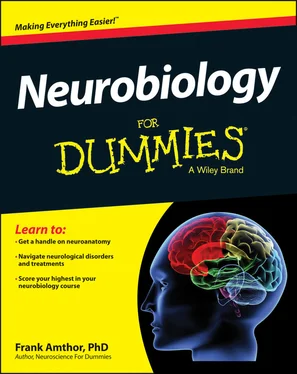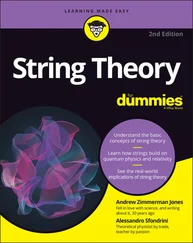The hypothalamus sits just above the pituitary gland and receives sensory input from the autonomic nervous system. It controls many homeostatic processes (such as circadian rhythms — the body’s internal “clock”) by secretions of hormones into the bloodstream and by projecting to the pituitary, which itself secretes hormones.
 The reticular formation is a diffuse network of neurons and axon tracts that runs through the brainstem up into portions of the thalamus. This area controls body state through processes such as controlling wakefulness versus sleep, alertness, and homeostatic mechanisms such as heart rate.
The reticular formation is a diffuse network of neurons and axon tracts that runs through the brainstem up into portions of the thalamus. This area controls body state through processes such as controlling wakefulness versus sleep, alertness, and homeostatic mechanisms such as heart rate.
Basal ganglia, cerebellum, motor and premotor cortex, and thalamus
Chapter 8takes up the basal ganglia, major controllers of behavior. The major basal ganglia nuclei include the caudate and putamen, which together make up the input region called the striatum. The globus pallidus is the major basal ganglia output to the motor portion of the thalamus, which projects and receives input from motor areas in the frontal lobe. The basal ganglia nuclei interact extensively with the substantia nigra in the midbrain, and the subthalamic nucleus.
The cerebellum is a motor learning and coordination center. It receives sensory input from spinal sensory neurons and cranial nerves of the vestibular and visual systems. Its major output is to motor thalamus that projects to frontal motor cortex. The cerebellum is necessary for learning coordinated, well-timed movements. It operates as a feed-forward controller that generates error signals used to reprogram motor areas such as premotor cortex to generate appropriate limb movements.
Two frontal areas just anterior to primary motor cortex, the supplementary motor area (SMA) and premotor cortex (PMC), contain motor programs that command and coordinate multi-limb movements to accomplish goals. One main difference between these two areas is that motor programs in SMA tend to be those that we can learn to do with little sensory feedback, such as typing. PMC control tends to occur when sequences are being learned, and depends more on peripheral feedback and cerebellar error signals.
The thalamus is often called the gateway to the neocortex, since all senses — except for some of olfaction (the sense of smell) — relay through it. But the neocortex projects back extensively to the thalamus. These back projections come from “higher” cortical areas, as well as from the primary areas that receive inputs from that area of the thalamus.
 The gateway metaphor for the thalamus implicitly makes the neocortex the real seat of neural control and computation. The thalamus is the modulator of transmission to the cortex, emphasizing some pathways at the expense of others as a mediator of attention. A different metaphor for thalamic-cortical interactions is that the thalamus is running the “main” program, which makes “subroutine” calls to the neocortex for some detailed neural computations. This makes processing in the thalamus the primary controller of brain activity, including consciousness (see Chapter 14). Activity in the neocortex becomes the content of that consciousness. It’s too early to say whether this subroutine metaphor will be as useful as the gateway metaphor has been.
The gateway metaphor for the thalamus implicitly makes the neocortex the real seat of neural control and computation. The thalamus is the modulator of transmission to the cortex, emphasizing some pathways at the expense of others as a mediator of attention. A different metaphor for thalamic-cortical interactions is that the thalamus is running the “main” program, which makes “subroutine” calls to the neocortex for some detailed neural computations. This makes processing in the thalamus the primary controller of brain activity, including consciousness (see Chapter 14). Activity in the neocortex becomes the content of that consciousness. It’s too early to say whether this subroutine metaphor will be as useful as the gateway metaphor has been.
The neocortex is one of the most important “inventions” of mammals. It dominates the mammalian brain in volume, particularly in primates. One of the most remarkable properties of the neocortex is that it has the same six-layered structure virtually everywhere, with the same cell types in what appears to be the same general minicolumn circuit. This is in stark contrast to the rest of the brain, where each area tends to have its own distinct set of cell types and neural circuits.
 Mammals became the dominant land animals on earth after the demise of the dinosaurs about 65 million years ago. Some neurobiologists conjecture that mammals were able to rapidly diversify into all the niches abandoned by the extinction of the dinosaurs, as well as many new ones, by expanding the standard neocortex circuit for processing whatever visual, auditory, or fine motor acuity that niche demanded.
Mammals became the dominant land animals on earth after the demise of the dinosaurs about 65 million years ago. Some neurobiologists conjecture that mammals were able to rapidly diversify into all the niches abandoned by the extinction of the dinosaurs, as well as many new ones, by expanding the standard neocortex circuit for processing whatever visual, auditory, or fine motor acuity that niche demanded.
Neocortical processing power is primarily a function of area. Increased area in neocortex has two main uses:
Increasing “acuity,” whereby, for example, a larger area can support a higher density of peripheral receptors, such as retinal ganglion cells in the fovea or mechanoreceptors in the fingertips.
Increasing the number of processing stages in a hierarchy of “association” areas that are increasingly specific and powerful with respect to particular features. Examples are the fusiform face area that allows you to instantly identify thousands of faces that all have the same major features (eyes, nose, mouth) in the same relative positions.
 The neocortex goes digital
The neocortex goes digital
The expansion of the neocortex is reminiscent of the transition in the 1960s from analog to digital computers. When vacuum tubes and then transistors were made and handled individually, the most efficient control circuits were those in which a small number of devices modeled the control environment and generated a continuous control output from continuous inputs via the model.
But when integrated digital circuits arose using thousands and millions of transistors, it became more efficient to represent the control environment on standard microprocessors using software. This provided the advantages of acuity (insensitivity to transistor parameter values) and adaptability (software can be changed and augmented easily). The commonality of the representation and transformation of information in the cortical minicolumn appear to be an essential basis of its success in taking over the brain, and in mammals, including humans, taking over the earth.
Perceiving the World, Thinking, Learning, and Remembering
Different parts of the brain do different things. The front of the brain in the frontal lobe controls movement, the back and sides of the brain process sensory information. Specialized memory areas perform certain memory functions — the hippocampus and amygdala, for example. Chapters 10through 14deal with pathways and brain areas that process sensory information and memory, and produce motor output and thought.
Looking at vision and audition
The standard list of five major senses consists of vision, hearing, skin sensation, taste, and smell. The senses of limb position (called proprioception ) and limb movement and acceleration (called kinesthesis ) are built along similar lines and pathways with skin sensation.
Chapter 10deals with vision and audition, starting with the peripheral receptors in the eye and ear, and marching up the projection pathways through the thalamus and onto primary, secondary, and higher-order cortical processing areas. In many mammals, particularly primates, visual processing dominates the brain — so much so that just less than 50 percent of the neurons in the brain have their activity modulated by visual input. In both vision and audition, high-order brain areas process complex inputs, such as face-specific neurons in inferotemporal cortex in vision, and language’specific areas in audition such as Wernicke’s area.
Читать дальше

 The reticular formation is a diffuse network of neurons and axon tracts that runs through the brainstem up into portions of the thalamus. This area controls body state through processes such as controlling wakefulness versus sleep, alertness, and homeostatic mechanisms such as heart rate.
The reticular formation is a diffuse network of neurons and axon tracts that runs through the brainstem up into portions of the thalamus. This area controls body state through processes such as controlling wakefulness versus sleep, alertness, and homeostatic mechanisms such as heart rate.










